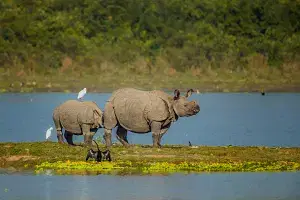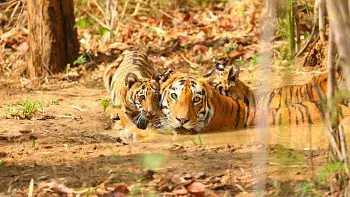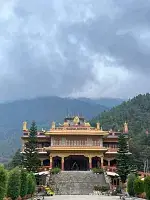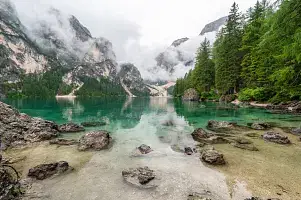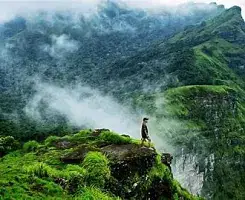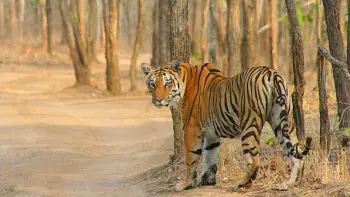Silent Valley National Park Travel Guide
Silent Valley National Park is a pristine destination nestled in the Western Ghats of India. Known for its untouched beauty and rich biodiversity, this park is a haven for nature lovers and wildlife enthusiasts. The park is famous for being one of the last undisturbed tracts of tropical rainforest in India, making it a UNESCO World Heritage Site.Top Attractions in Silent Valley National Park
- Explore the lush greenery of the tropical rainforest
- Spot rare and endangered species like the Lion-tailed Macaque
- Visit the serene Kunthi River and its picturesque waterfalls
- Embark on a guided trek to Sairandhri and Poochipara peaks
Silent Valley National Park is Famous for
Its pristine tropical rainforest and rich biodiversity.Top Attractions in Silent Valley National Park
- Discover rare flora and fauna in their natural habitat
- Enjoy birdwatching and wildlife spotting opportunities
- Experience the tranquility of the untouched wilderness
- Participate in eco-tourism activities for a sustainable visit
What's Great about Travelling to Silent Valley National Park?
- Perfect for nature lovers and wildlife enthusiasts
- Offers a chance to explore unspoiled rainforest ecosystems
- A peaceful retreat away from the hustle and bustle of city life
What's Not So Great about Travelling to Silent Valley National Park?
- Limited accommodation options within the park
- Remote location may require careful planning for transportation
- Strict rules to preserve the park's natural beauty and wildlife
Travel Tips for Silent Valley National Park
- Obtain necessary permits and permissions before visiting
- Follow eco-friendly practices and respect the park's rules
- Wear appropriate clothing and footwear for jungle treks
Important Silent Valley National Park trip information
- Ideal Duration: 2-3 days to fully explore the park
- Best Time to Visit: November to March for pleasant weather
- Nearby Airports and Railway Stations: Coimbatore International Airport and Palakkad Railway Station
Per Person
24,400
*EXCLUDING APPLICABLE TAXES Per Person
18,000
*EXCLUDING APPLICABLE TAXES Per Person
40,000
*EXCLUDING APPLICABLE TAXES Per Person
16,800
*EXCLUDING APPLICABLE TAXES 5.0 Ratings
( 4 Reviews )
( 4 Reviews )
Per Person
34,990
*EXCLUDING APPLICABLE TAXES Per Person
15,000
*EXCLUDING APPLICABLE TAXES FAQ's on Silent Valley National Park
Q1: What is the best time to visit Silent Valley National Park?
The best time to visit Silent Valley National Park is from September to March when the weather is pleasant, and the park is lush and green after the monsoon season. This period offers ideal conditions for wildlife sightings and trekking activities. It is advisable to avoid the monsoon months of June to August due to heavy rainfall that can disrupt travel plans and make the trails slippery and challenging.
Q2: Do I need a visa to travel to Silent Valley National Park?
As Silent Valley National Park is located in India, international tourists will need to obtain an Indian tourist visa to visit the park. The visa application process varies depending on your nationality, so it is essential to check the specific requirements and apply for the visa well in advance of your travel dates. Visitors should ensure their passport is valid for at least six months from the date of entry into India.
Q3: What are the must-visit attractions in Silent Valley National Park?
Silent Valley National Park is renowned for its rich biodiversity and stunning landscapes. Must-visit attractions include the Sairandhri Visitor Center, which provides information about the park's flora and fauna, the Kunthi River, a picturesque spot for picnics, and the Silent Valley Viewpoint offering panoramic views of the park. Trekking to the peaks of Sispara and Karimala is a popular activity for adventure enthusiasts. Wildlife enthusiasts can spot endangered species like the Lion-tailed Macaque and Nilgiri Langur in their natural habitat.
Q4: Is Silent Valley National Park a safe place to travel?
Silent Valley National Park is generally considered safe for tourists. However, it is essential to follow safety guidelines provided by park authorities, especially while trekking or exploring remote areas. It is advisable to hire local guides for trekking expeditions and avoid straying off designated trails. Visitors should also be mindful of wildlife and refrain from feeding or approaching animals. As with any natural reserve, it is recommended to respect the environment and follow park rules to ensure a safe and enjoyable experience.
Q5: What is the local currency in Silent Valley National Park and can I use credit cards?
The local currency in India is the Indian Rupee (INR). While credit cards are accepted in major cities and tourist establishments, it is advisable to carry cash when visiting Silent Valley National Park as rural areas may have limited card payment facilities. ATMs are available in nearby towns like Mannarkkad and Mukkali, but it is recommended to withdraw sufficient cash before entering the park as there may not be ATMs within the reserve.
Q6: What is the local cuisine like in Silent Valley National Park?
The local cuisine in the region surrounding Silent Valley National Park offers a blend of traditional Kerala dishes influenced by the indigenous tribes and local communities. Visitors can savor authentic Kerala delicacies like Appam, Puttu, and Fish Curry prepared with fresh ingredients and aromatic spices. Vegetarian options like Avial and Thoran are also popular choices. Travelers with dietary restrictions can find options such as steamed rice and lentil dishes. It is recommended to try local eateries and roadside stalls for a taste of the region's culinary diversity.
Q7: What transportation options are available in Silent Valley National Park?
Transportation options to Silent Valley National Park include hiring a private vehicle, taking a bus to Mukkali, or arranging a taxi from nearby towns like Mannarkkad. Once inside the park, visitors can explore on foot or join guided treks organized by the forest department. Public buses are available from Palakkad and Mannarkkad to Mukkali, the entry point to the park. It is advisable to book transportation in advance, especially during peak tourist seasons, to ensure a smooth journey to and from Silent Valley National Park.
Q8: Are there any cultural norms or etiquette I should be aware of when visiting Silent Valley National Park?
When visiting Silent Valley National Park, it is essential to respect the local culture and customs of the indigenous tribes and communities in the region. Modest clothing is recommended, especially when interacting with local residents or visiting religious sites. It is customary to remove shoes before entering temples or homes as a sign of respect. Photography restrictions may apply in certain areas, particularly around tribal settlements, so it is advisable to seek permission before taking pictures. Visitors should refrain from littering and follow eco-friendly practices to preserve the natural beauty of the park. Engaging with local guides and residents can provide valuable insights into the culture and traditions of Silent Valley National Park.
Q9: I am a travel agent. How can I buy travel leads of Silent Valley National Park?
Register yourself as a travel agent at agents.tripclap.com and then you can buy travel leads to Silent Valley National Park once your account is approved. For more details contact our support team at +91-8069186564 or support@tripclap.com
